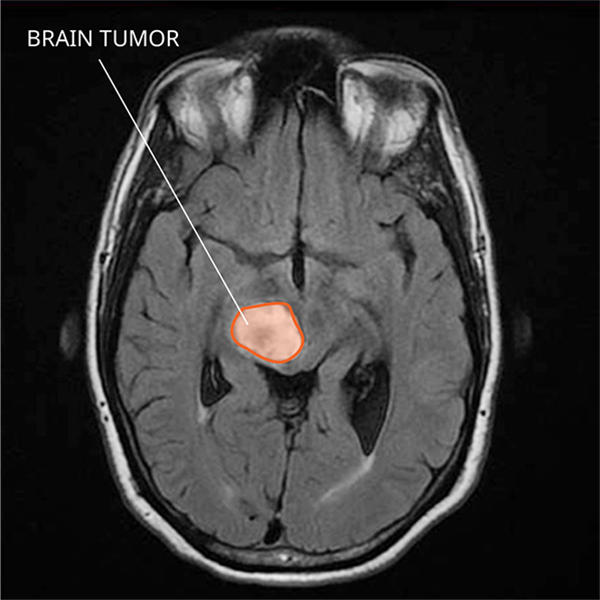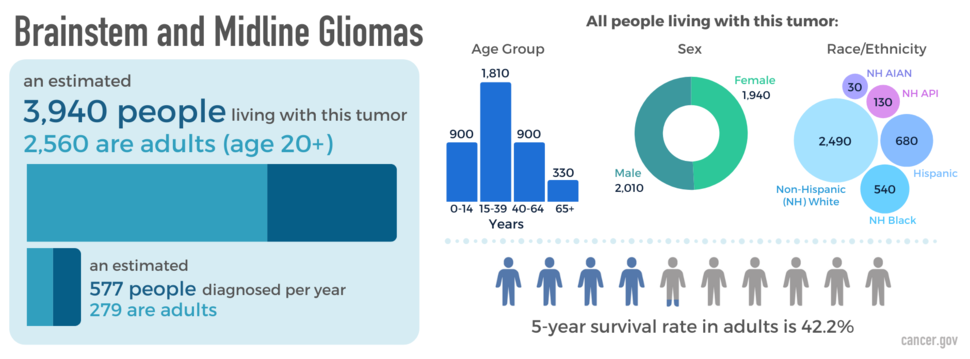Diffuse midline gliomas are primary central nervous system (CNS) tumors. This means they begin in the brain or spinal cord. They are a rare subtype of glial tumors.
To get an accurate diagnosis, a piece of tumor tissue will be removed during surgery, if possible. A neuropathologist should then review the tumor tissue.
What Are the Grades of Diffuse Midline Gliomas?
Primary CNS tumors are graded based on a tumor tissue analysis performed by a neuropathologist. Diffuse midline gliomas are all grade 4 (also written as grade IV). This means they are malignant (cancerous) and fast-growing.
What Do Diffuse Midline Gliomas Look like on an MRI?
On a magnetic resonance imaging (MRI) scan, diffuse midline gliomas usually appear as a mass that has spread in the middle area of the brain. The tumor shows degrees of brightness with contrast. In adults, a diffuse midline glioma diagnosis can’t be made by imaging alone, because the tumors look similar to glioblastomas and other high-grade brain cancers.
What Causes Diffuse Midline Gliomas?
Cancer is a genetic disease—that is, it is caused by certain changes to genes that control the way our cells function. Genes may be mutated (changed) in many types of cancer, which can increase the growth and spread of cancer cells.
The cause of diffuse midline gliomas is not known. However, people with gene changes that can be passed down through families—such as Li-Fraumeni syndrome and Neurofibromatosis type I—are at an increased risk. Changes in a gene known as h3K27M have also been linked to diffuse midline glioma growth.
Where Do Diffuse Midline Gliomas Form?
Diffuse midline gliomas most often form in the thalamus, spinal cord, cerebellum, and the pons in the brainstem. It’s uncommon for these tumors to occur in other areas of the CNS. Diffuse midline gliomas are named, in part, based on the locations where they form most often. Therefore, tumors in other CNS locations thought to be diffuse midline glioma should be reviewed by neuro-oncology providers with experience treating these specific tumors.
Diffuse midline glioma is a rare type of astrocytoma that looks similar to other, more common astrocytomas (such as a glioblastoma) under a microscope. Because it can be hard to tell them apart, molecular testing is required. Some diffuse midline gliomas have changes in histone-related genes. The most common gene is h3K27M. A neuropathologist should confirm the diagnosis.
Do Diffuse Midline Gliomas Spread?
Diffuse midline gliomas are fast-growing tumors and can spread to other areas of the CNS through cerebrospinal fluid (CSF). The tumor can invade nearby tissue and extend beyond what is seen on MRI or by the surgeon during surgery. However, diffuse midline gliomas usually come back in the same location where they first appeared.
What Are the Symptoms of a Diffuse Midline Glioma?
Diffuse midline glioma symptoms depend on the tumor’s location. Here are some possible symptoms that can occur:
- Double vision
- Problems swallowing
- Weakness on one or both sides of the body
- Loss of balance
Diffuse midline gliomas in the brain may also cause increased pressure within the skull due to too much production of CSF or blockage of its normal flow. This is known as hydrocephalus.
Signs and symptoms of hydrocephalus may include:
- Nausea
- Vomiting
- Irritability
- Headaches
- Blurred or double vision
- A strong desire to sleep
- Seizures
People with a diffuse midline glioma in the spine may have:
- Progressive weakness
- Numbness
- Problems with bowel and bladder control
Who Is Diagnosed with a Diffuse Midline Glioma?
Diffuse midline gliomas occur in both children and adults. They are most common in non-Hispanic white people. An estimated 3,940 people are living with this tumor in the United States.
What Is the Prognosis of a Diffuse Midline Glioma?
The likely outcome of the disease or chance of recovery is called prognosis. Prognosis is based on the tumor grade, location, tumor type, extent of tumor spread, genetic findings, patient’s age, and tumor remaining after surgery (if surgery is possible).
The relative five-year survival rate for diffuse midline glioma is 42.2 percent. However, there are many factors that can affect prognosis. These include the tumor grade and molecular type, the person’s age and health when diagnosed, and how they respond to treatment. If you want to understand your prognosis, talk to your doctor.
What Are the Treatment Options for Diffuse Midline Gliomas?
The first treatment for diffuse midline glioma is surgery, if possible. The goal of surgery is to obtain tissue to determine the tumor type and remove as much tumor as possible without causing more symptoms. The brainstem, thalamus, and spinal cord are sensitive locations in the CNS, and surgery in these areas can cause serious loss of function. As a result, diffuse midline gliomas may sometimes be treated using radiation therapy alone without a biopsy if the risk of biopsy is too high. If the patient has hydrocephalus, a procedure (such as a ventriculoperitoneal shunt) may also be needed to redirect the flow of CSF.
Diffuse midline gliomas usually require additional treatments as well. In most cases, surgery is followed by radiation therapy. Chemotherapy is sometimes given with or after radiation. However, there is no standard chemotherapy regimen, and each plan should be tailored to the individual patient.
A team of experts—including neuro-oncologists, neuroradiologists, radiation oncologists, and neurosurgeons—should review the tumor to determine the best treatment plan. Clinical trials testing new chemotherapy, targeted therapy, or immunotherapy drugs may also be available.
Open Clinical Studies for Diffuse Midline Gliomas
- PLX038 in CNS Tumors
- Immune Checkpoint Inhibitor Nivolumab for Patients with Rare CNS Cancers
- ONC206 for Patients with Rare CNS Neoplasms
Learn More
- Video: Clinical Trial Tests Nivolumab for Patients with Rare Brain and Spine Cancers
- Working Through a Life-Changing Rare Brain Tumor Diagnosis
- New Study Reveals Data on Rare CNS Tumors to Inform Clinical Care and Evaluate Novel Cancer Treatments
- Histone Mutated Midline Glioma Workshop Report
- Read our NCI-CONNECTions Blog for recent news and information on rare brain and spine tumors.
Referrals
NCI-CONNECT doctors and nurses work with you and your primary doctor to collaborate on a comprehensive care plan that treats your brain or spine tumor. They will also help you cope with the physical and emotional aspects of your diagnosis. Learn about requesting a consultation >



